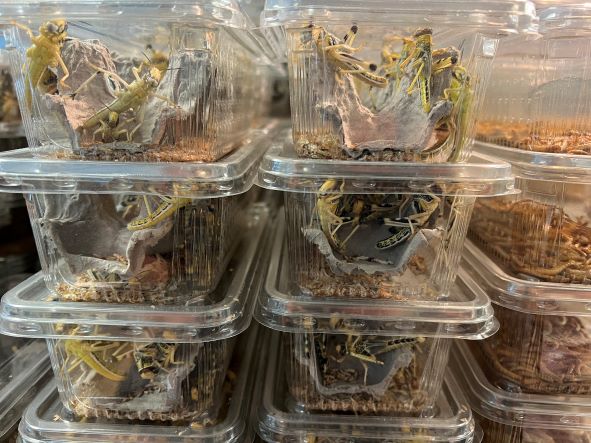Many reptiles, amphibians and invertebrates require livefood (insects and other invertebrates) as a whole or part of their diet. Some mammals such as pygmy hedgehogs do to. At Angell Pets we have stocked a range of livefood options since we opened over 13 years ago.
We often get new customers who have been buying their livefood either on line or at a chain store comment on the quality, condition and price of our livefood when they first come in. Our pre-existing customers have obviously been benefitting from this qualityfor some time and know why they shop with us. How do we keep our prices down and quality up? Well hard work and care mainly

Sticking a box of livefood on a shelf and leaving it there until a customer picks it up is just about it for most outlets. Not us. When we get the livefood in from one of our high quality suppliers (on their own temperature controlled vehicles, not via courier where the heat of summer or cold of winter decimates the stock before it even arrives) it is first inspected for quality. Any substandard packs are removed and not put onto our shelves. Fortunately for us this is a rare occurence and is usually where a tub lid may have come off in transit. The tubs of livefood are then fed, usually with a thin slice of organic carrot, before putting on the shelf for sale. It would be easy to just put in a large slice and leave it at that for the week but it is important that all the food is eaten before it has a chance to spoil. Too large a piece and it will start to rot and spoil the tub of livefood. For this reason we revisit each and every tub three times a week to remove any uneaten food, replace with a fresh slice and also remove any moulted skins from the insects (crickets, locusts, mealworms, morio worms etc.). This is very time consuming and fiddly but essential if we are to keep up our excellent standard of livefood that our customers have come to expect. As I write this blog it is a bank holiday Monday. When I have finished the first draft here I am off to the shop to feed and water the animals (reptiles, amphibians, birds, mammals and fish) and yes, feed all the livefood tubs on the shelf.

Toward the end of the week, especially in the large and extra large sizes during the summer months, some of the tubs will have grown into adults or started to deteriorate. We then go through every tub, removing any dead insects and replacing with live ones (consolidating the tubs) to ensure a tub bought on a Wednesday afternoon is as good as a tub bought on a Thursday morning when the fresh delivery arrives. We also consantly review the numbers ordered and we have become quite good at ensuring we order just enough to keep stock on the shelf for the week and are just running out when the new stock arrives so the tubs are never older than a week and look as fresh as when delivered.

Why do we go to all this effort. Well, the main reason is it is important the the food you feed your animal is as full of nutrients as possible. Just being alive is not enough. A starving, dehydrated locust, with an empty gut and not enough energy to really move let alone grow is not as benificial to your animal as one that is fit and healthy. Also by keeping our tubs of livefood well fed and hydrated we ensure we lose very little stock to spoilage. Each tub lost is a tub not sold so effects the return on our investment. By ensuring spoilage is at a minimum we are able to control costs to the business and keep the price to our customers down. Finally although reptiles, amphibians and invertebrates such as tarantulas do require livefood to survive we believe we have a responsibility to these insects whilst they are in a our care. Just letting a tub die because “they are just crickets” doesn’t wash with us.
We hope you as a customer share our views on the importance of looking after livefood for the benefit of you and your animal and look forward to seeing you during the week when you can be confident that you are getting the best quality for the best possible price.

